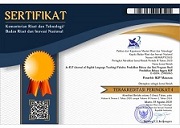PRINCIPLES OF SECOND LANGUAGE ACQUISITION IN CHILDREN
Abstract
To understand the principles of second language acquisition, we could adopt a variety of perspective. Research on second language acquisition (SLA) by children and adults is characterized by many different subfields and perspectives, both cognitive and social in orientation. Although children feature as participants in this research, it is relatively rare to find reviews or overviews of SLA that deal specifically with child SLA although there are a few important exceptions. This general lack of focus on children’s SLA is somewhat surprising, considering that data from children as first language learners have often provided a basis and impetus for SLA theorizing. Among the best-known first language studies to prove influential was Brown’s seminal work showing a predictable order of morpheme acquisition by children under the age of three. Many early years settings now welcome children and families from different cultures who use languages other than English. Young children who are starting to learn English as an additional language may also be attending a nursery school, pre-school, day nursery or child-minder perhaps for the first time. They will bring with them many skills and experiences from their home culture and will be both anxious and excited about their new situation. A good foundation for learning English as an additional language is embedded in quality early years practice. To know more about the principle of second language acquisition in children, this paper will present some issues related with it such as the nature and the role of language learning and the logical problem in language learning.
Keywords
Full Text:
PDFReferences
Kay, Crosse. (2007). Introducing English as an Additional Language to Young Children: A Practical Handbook. Paul Chapman Publishing.
Lightbown, P. M., & Spada, N. (1999). How Languages are Learned (Second Edi). Oxford: Oxford University Press.
Bialystok, E., & Hakuta, K. (1994). In Other Words: The Science and Psychology of Second-LanguageAcquisition. New York: Basic Books.
Gass, S.M., & Selinker, L. (2008). Second Language Acquisition: An Introductory Course. New York: Routledge Taylor & Francis Group.
Troike, M.S. (2005). Introducing Second Language Acquisition. Cambridge: Cambridge University Press.
DOI: https://doi.org/10.33394/jo-elt.v3i1.2424
Refbacks
- There are currently no refbacks.
Copyright (c) 2016 Haerazi Haerazi

This work is licensed under a Creative Commons Attribution-ShareAlike 4.0 International License.
Jo-ELT (Journal of English Language Teaching) Fakultas Pendidikan Bahasa dan Seni Program Studi Pendidikan Bahasa Inggris IKIP is abstracted/indexed in the following databases:
Published by Faculty of Culture, Management, and Business
Universitas Pendidikan Mandalika
p-ISSN: 2355-0309 | e-ISSN : 2548-5865
email: [email protected]
 Jo-ELT (Journal of English Language Teaching) Fakultas Pendidikan Bahasa dan Seni Program Studi Pendidikan Bahasa Inggris IKIP is licensed under a Creative Commons Attribution-ShareAlike 4.0 International License.
Jo-ELT (Journal of English Language Teaching) Fakultas Pendidikan Bahasa dan Seni Program Studi Pendidikan Bahasa Inggris IKIP is licensed under a Creative Commons Attribution-ShareAlike 4.0 International License.





1.jpg)








1.png)

.png)








